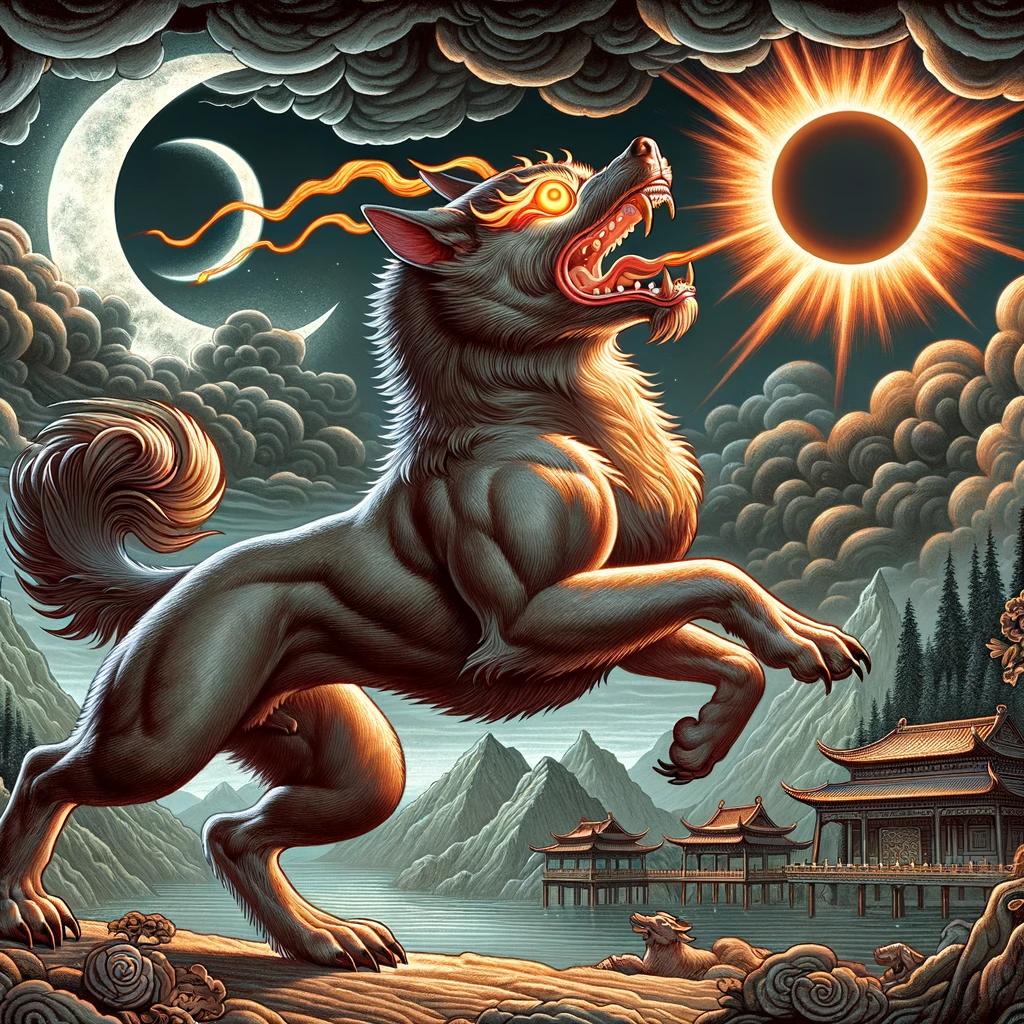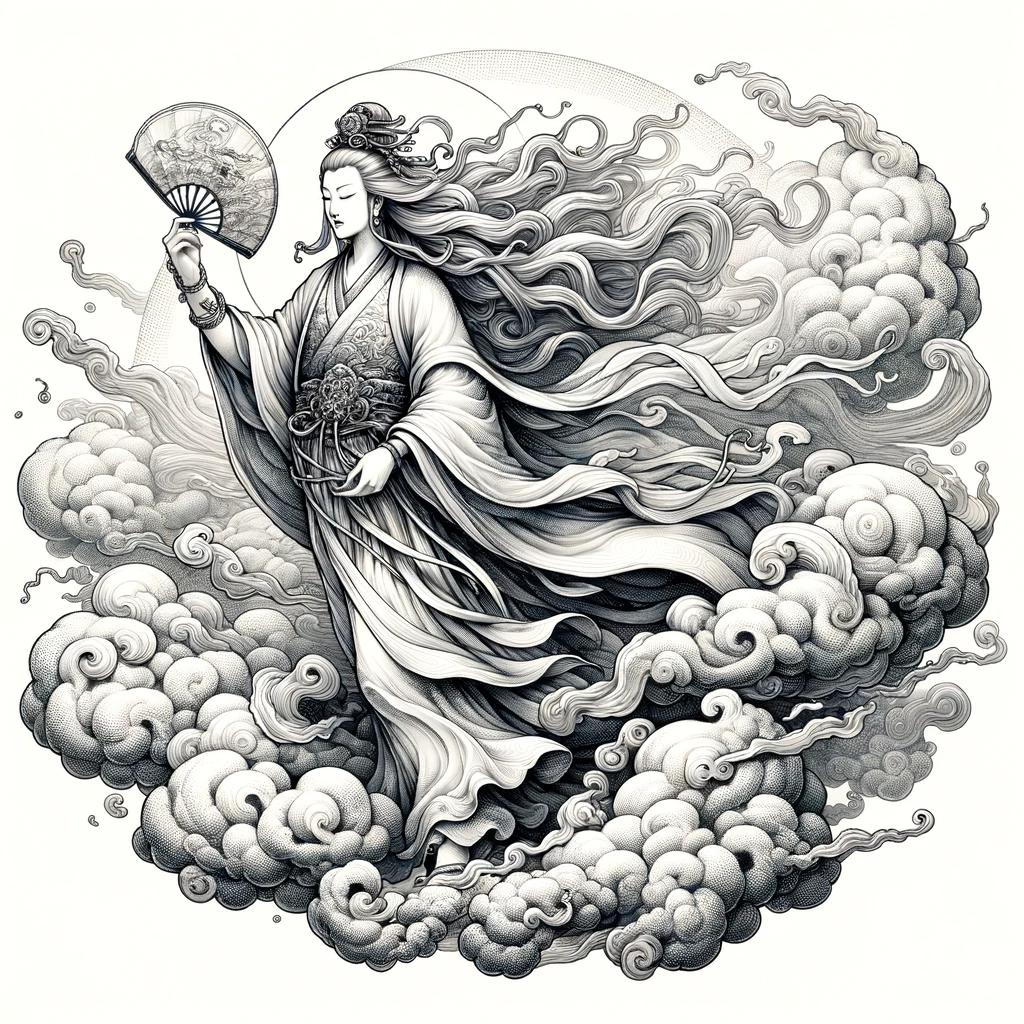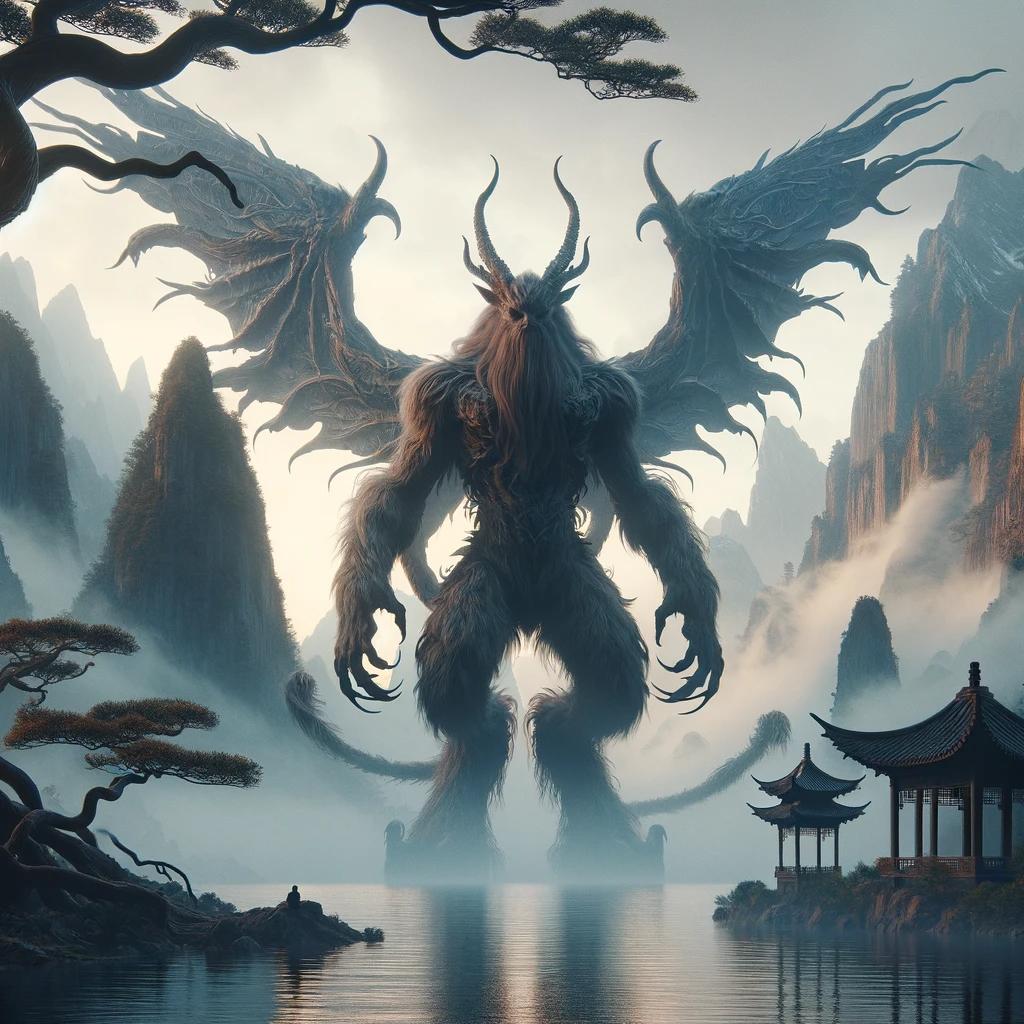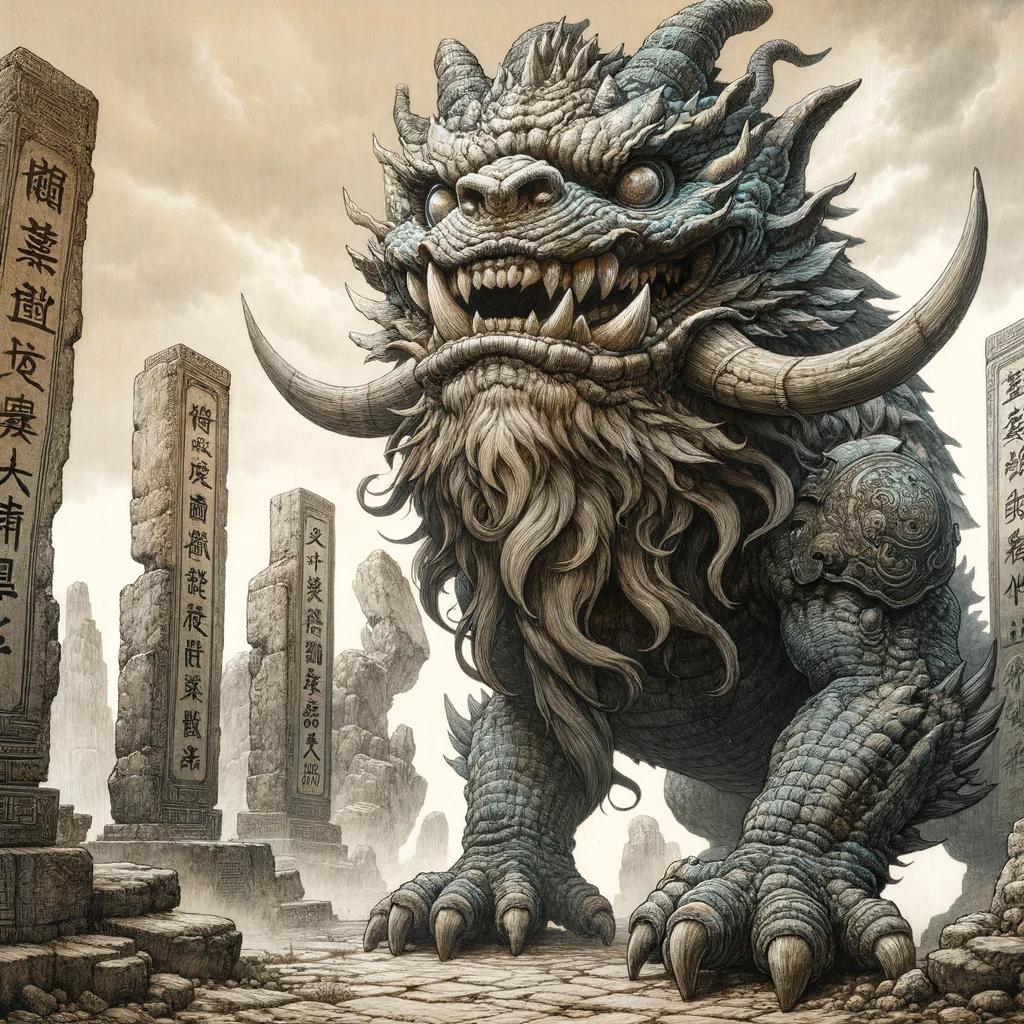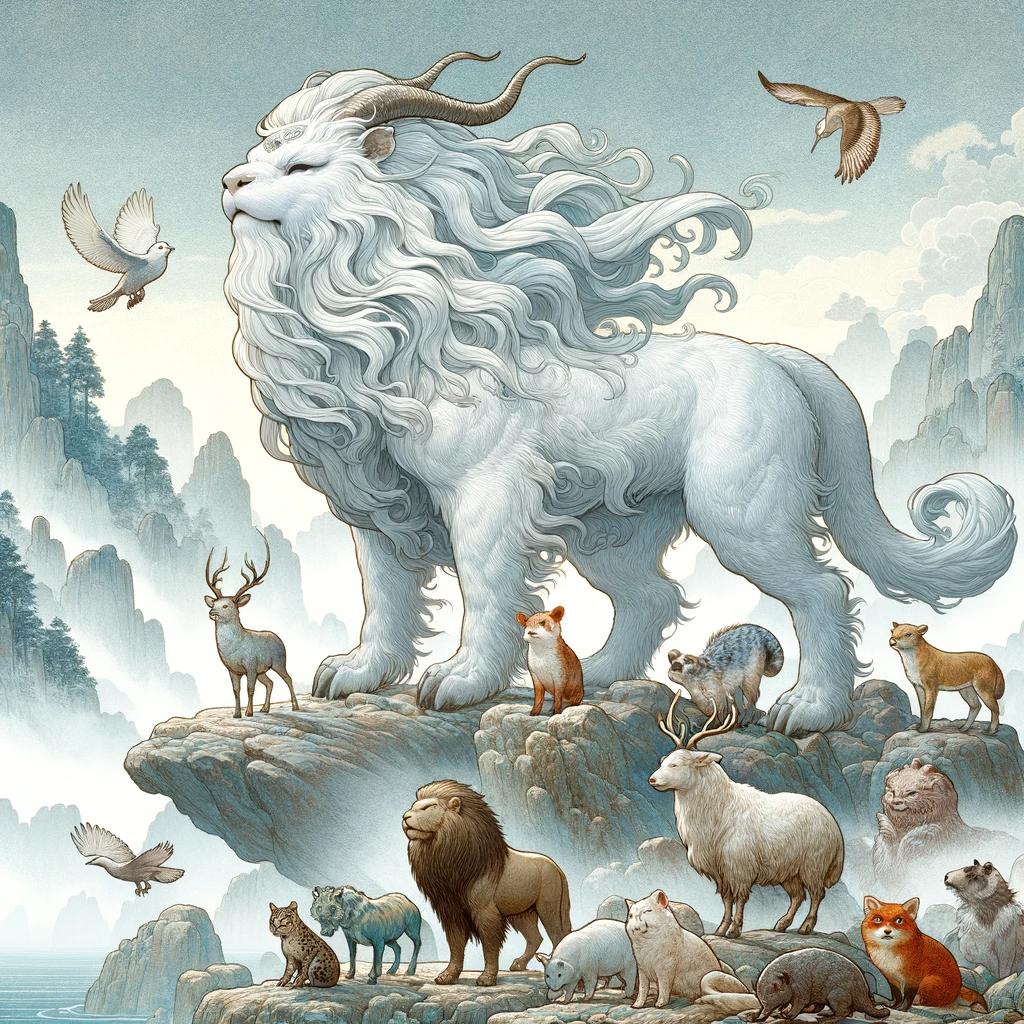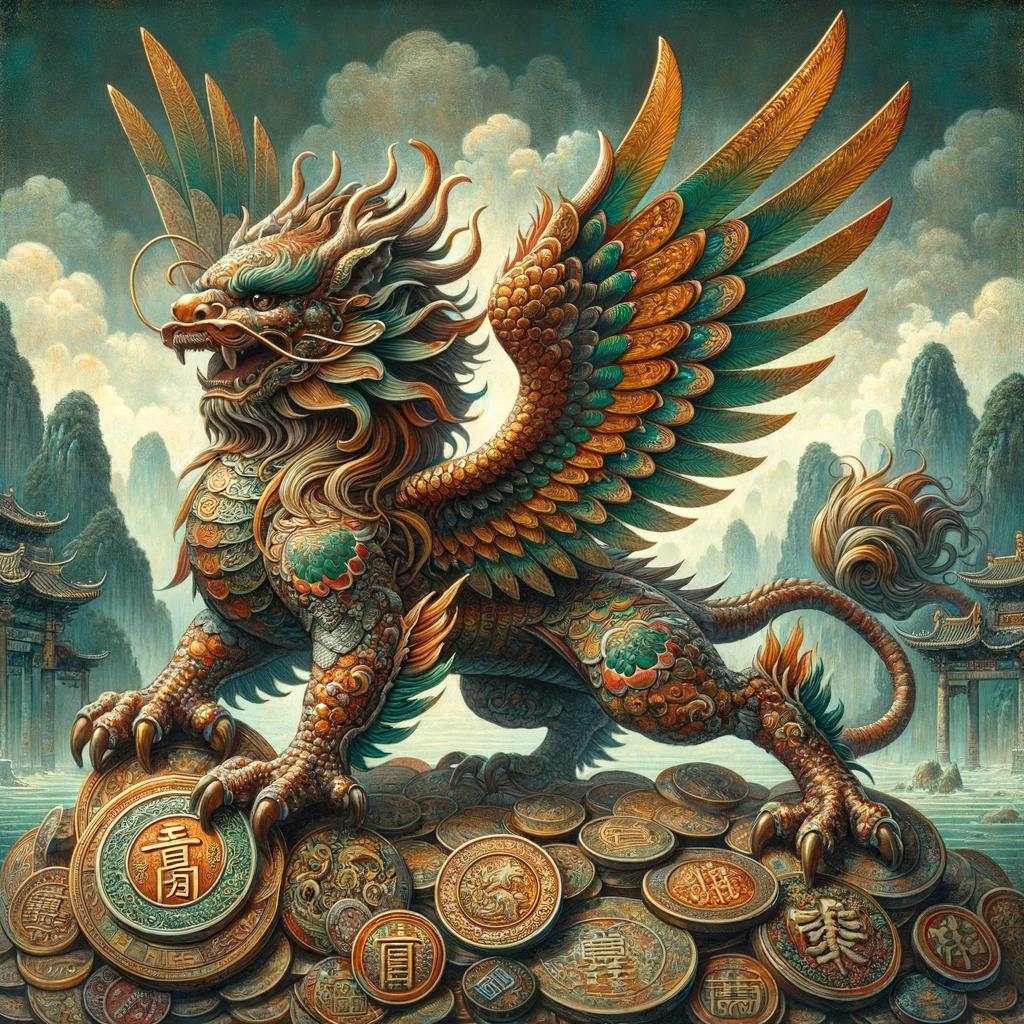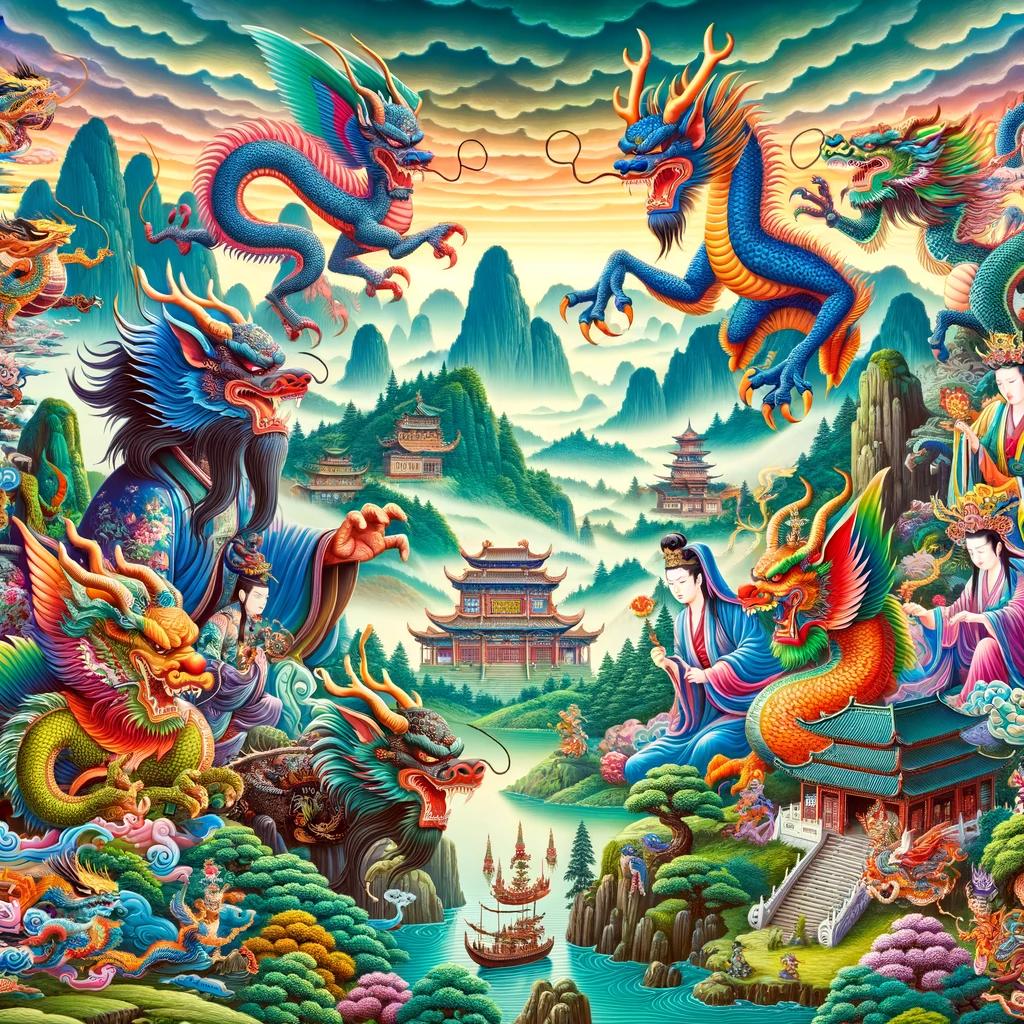Exploring the Mythical Tiangou: Guardian of the Heavens
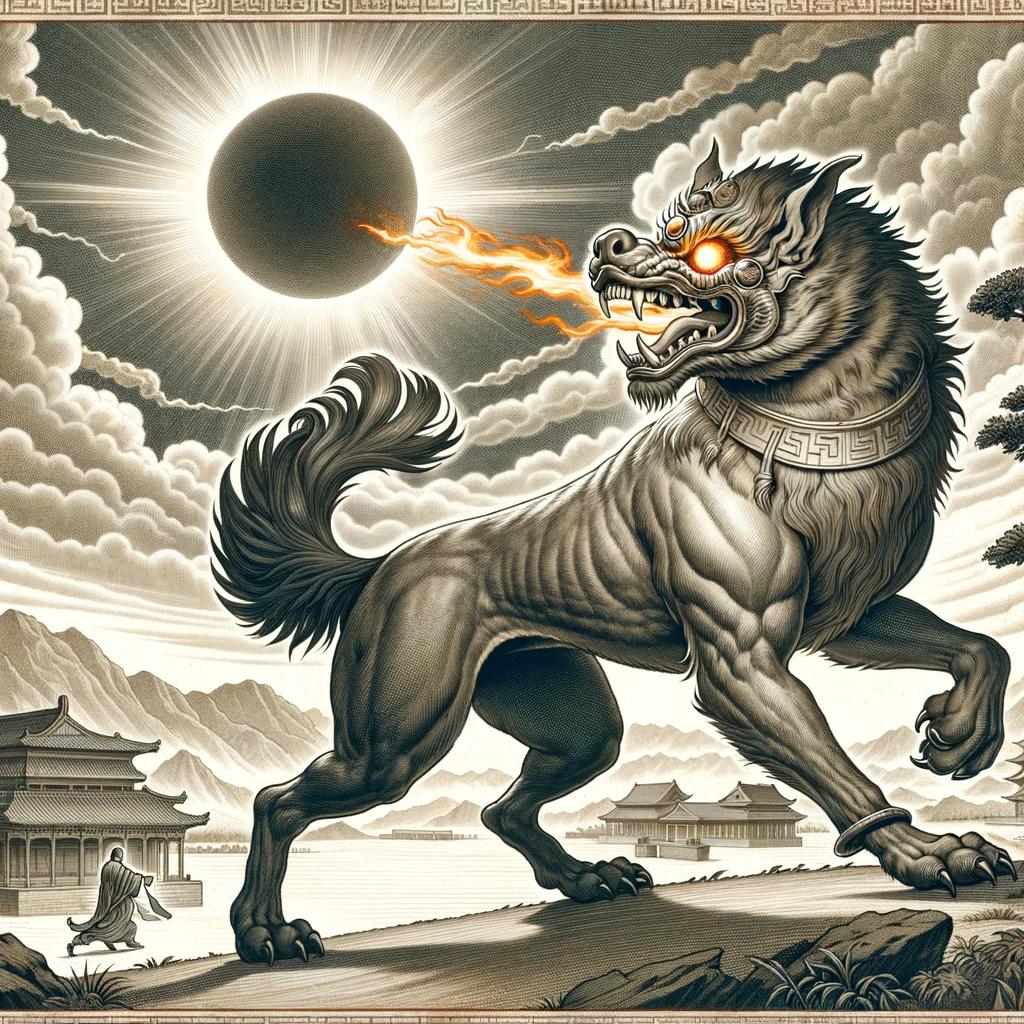
The Tiangou dog, a mythical creature from Chinese mythology, often depicted as a black dog or a celestial meteorite, holds a revered place in the annals of Chinese folklore.
According to legends, it is believed to devour the sun or the moon during eclipses, a phenomenon deeply intertwined with moon dog mythology and heavenly dog mythology.
This mythical creature also holds a significant role in various Chinese myths and is associated with figures like Houyi and Zhang Xian, embodying the essence of both mythical dog creatures and mythical dog-like creatures.
In this article, we will explore the origins, symbolism, and dual nature of Tiangou, as well as its connections to other Chinese mythical creatures and its influence in modern culture.
Let’s delve into the intriguing world of the Tiangou dog, a symbol of protection, cosmic balance, and ancient wisdom.
The Legend of Tiangou Dog
The Tiangou dog, deeply rooted in Chinese mythology, often depicted as a black dog or a celestial meteorite, plays a significant role in ancient tales and legends. According to mythological accounts, Tiangou is believed to possess the power to devour the sun or the moon during eclipses, creating a sense of awe and wonder—a testament to its role in moon dog mythology and heavenly dog mythology.
The origins of Tiangou, shrouded in mystery and steeped in Chinese dog mythology, have been passed down through generations.
This mythical creature’s existence can be traced back to ancient times, capturing the imaginations of the Chinese people. Tiangou’s legend has been depicted in various forms of art, literature, and cultural practices, solidifying its significance in Chinese folklore and linking it to the broader tapestry of Chinese mythical creatures.
Origins and Representation of Tiangou
The precise origin of Tiangou remains elusive, but it is generally associated with celestial events, cosmic powers, and heavenly dog mythology. This mythical creature is believed to have connections to heavenly bodies, primarily the sun and the moon.
Its appearance as a black dog or a meteorite reflects its association with the night sky, celestial phenomena, and the myth of the tiangou meaning—a heavenly dog that eats the sun or moon, echoing themes found in moon dog mythology.
Tiangou Dog as a Symbol in Chinese Mythology
In Chinese mythology, Tiangou holds symbolic significance, representing both positive and negative forces. As a protector of the heavens, its presence is believed to bring harmony and balance, offering protection from celestial threats and earthly dangers such as thieves and robbers.
Tiangou’s role extends beyond celestial guardianship to its association with various mythological figures and events, embodying the spirit of chinese demon dog and heavenly dog mythology.
Although Tiangou is commonly known for its malevolent nature as the creature that devours the sun or the moon, there is a duality to its character.
It also assumes the form of a white-headed fox, embodying a spirit of peace, tranquility, and protection against life’s troubles, much like the protective spirits found in chinese wolf mythology and the tales of black dogs offering safeguarding qualities.
Throughout Chinese mythology, Tiangou’s symbolism evolves, adapting to different narratives and legends. It represents the complexities of human existence, capturing both the light and dark aspects of life and the universe, including its role as a chinese mythical dog intertwined with stories of the dog eating the moon according to ancient beliefs, and its sightings in the skies as a meteor which heralds its appearance.
Understanding the Tiangou Mythology
The Tiangou is a fascinating creature deeply rooted in Chinese mythology.
This section aims to explore the origins and representations of the Tiangou, as well as its symbolic significance in Chinese mythos, reflecting its multifaceted nature as a creature of both destruction and protection, embodying the essence of chinese mythical dog lore and its place in the realm of chinese mythical creatures.
Origins and Representation of Tiangou
The origins of the Tiangou can be traced back to ancient Chinese beliefs and folklore, embodying the narrative of the tiangou puppy, the legendary creature often portrayed as a black dog or even a celestial meteorite.
This legendary creature, with extraordinary powers and an insatiable appetite for devouring heavenly bodies, symbolizes the balance between the cosmos and the earthly realm, casting a long shadow over the rich tapestry of Chinese dog mythology and heavenly dog mythology.
Throughout
history, the Tiangou has been associated with eclipses, believed to be responsible for consuming the sun or the moon during these astronomical events. Its representation as a fierce black dog signifies its connection to darkness, mystery, and the supernatural, embodying the essence of mythical dog-like creatures and the creature from China that eats the moon or is seen eating the sun during a lunar eclipse.
Tiangou Dog as a Symbol in Chinese Mythology
Within Chinese mythology, the Tiangou plays a significant symbolic role. It is often perceived as a harbinger of change and upheaval, representing the forces of nature, the cyclical nature of life, and the intricate balance between the mountains and seas.
The Tiangou’s appearance during an eclipse is seen as an omen, warning of impending turmoil or transformation, echoing the deep-rooted belief in dogs in Chinese mythology and the tian gou meaning as a divine force.
Furthermore, the Tiangou’s dual nature, as both a good and malevolent spirit, reflects the duality present in many Chinese myths.
As a white-headed fox, the Tiangou is revered as a protector, bringing peace, tranquility, and safeguarding the constellation of happiness. Conversely, as a black dog, it is associated with darkness, destruction, and the devouring of celestial bodies, mirroring the tianghou narrative of celestial intervention.
In Chinese culture, the Tiangou symbolizes the delicate balance between opposing forces and serves as a reminder of the ever-changing nature of existence. It teaches us to navigate both the light and dark aspects of life and find harmony amidst chaos, illustrating the profound impact of the moon and celestial phenomena on the gates of perception.
- Origins and representations of Tiangou
- Tiangou dog as a symbol in Chinese mythology
Continuing our journey into the intriguing world of the Tiangou, the following sections will explore its dual nature and its connection to the legendary tale of Houyi, Chang Er, and their interactions with this mythical entity.
The Dual Nature of Tiangou
The Tiangou dog exhibits a fascinating duality in Chinese mythology, embodying both good and malevolent spirits, and portraying the endless cycle of the moon and celestial dynamics. Let’s explore further the contrasting aspects of Tiangou and its symbolic associations.
Tiangou as a Good Spirit: White-Headed Fox
Within the realm of benevolent spirits, Tiangou manifests as a White-Headed Fox.
Tiangou as a Malevolent Spirit: The Black Dog
In contrast, Tiangou takes on a malevolent form as a fearsome Black Dog. In this incarnation, it is infamous for its insatiable appetite for devouring the moon during eclipses, becoming a spectral dog that eats celestial bodies.
Ancient Chinese folklore warns of the menacing nature of this spectral creature and its relentless pursuit of cosmic entities, a narrative that enriches the lore of the Tiangou resembles the dark forces lurking within mountains and seas.
By embodying both good and evil aspects, Tiangou represents the delicate balance between light and darkness, illustrating the complexities of Chinese mythology and the wider human experience, including tales of the moon and Chang Er’s encounter with this formidable beast.
Tiangou and the Houyi-Chang Er Legend
The legend of Tiangou is closely intertwined with the story of Houyi and Chang Er, two significant figures in Chinese mythology. Their legendary encounter with the Tiangou dog, featuring chased after Chang Er and licked the remains of the elixir that allowed her to maintain her youth, adds a layer of complexity and intrigue to the myth, illustrating the profound symbolism of Tiangou in the cosmic balance of lighter and flew away seeing this, moon and Chang Er’s ascent to the heavens.
Houyi:
The Archer Who Shot Down Suns
Houyi, a skilled archer, was tasked with a monumental mission – to save the Earth from scorching heat caused by ten suns in the sky. Armed with his bow and arrows, he successfully shot down nine of the suns, proving his unparalleled prowess and ensuring the balance between the sun and moon.
Chang Er’s Encounter with Tiangou
However, the story takes an unexpected turn when Chang Er, Houyi’s wife, consumes the elixir that grants immortality. Panicked by the consequences, Chang Er flees and finds refuge on the moon, hiding behind the moon.
Meanwhile, a black dog that Houyi had once raised licks the remnants of the pill, transforming into the Tiangou, a legendary creature from the ancient lore, thus becoming the Tiangou Chinese mythology reveres.
Tiangou’s Transformation and Role in the Sky
The Tiangou, now a celestial guardian, continues to chase Chang Er across the sky. Over time, Chang Er and the moon are perceived as protected by Tiangou, who assumes its duty as the gatekeeper of the heavens, guarding the gates and maintaining the cosmic order.
This transformation highlights the mythical nature of Tiangou, intertwined with the Houyi-Chang Er legend and its celestial symbolism, illustrating how the black dog ate the remnants of the elixir and became a guardian of the sun and moon during celestial events.
This captivating legend encompasses themes of sacrifice, transformation, and the eternal battle between good and evil, captured the dog and the myth surrounding its role as the protector of the celestial realms.
Tiangou’s Connection with Zhang Xian
Zhang Xian, known as the guardian of childbirth and protector of male children, especially boys, plays a significant role in the Tiangou mythology. As the malevolent spirit, Tiangou poses a threat to young ones during eclipses, but it is Zhang Xian who stands as their defender, armed with his bow and arrows.
Zhang Xian: The Protector against Tiangou Attacks
Zhang Xian is revered as a deity who safeguards children from the vicious attacks of Tiangou. Legends depict Zhang Xian as an archer, chasing after and attacking the dog with arrows to fend off the relentless assaults of the colossal dog-like creature.
During eclipses, when Tiangou is believed to attempt devouring celestial bodies, Zhang Xian’s arrows pierce the darkness, thwarting its advances and ensuring the safety of children, guarding the gates against the chaos wrought by Tiangou.
The association between Zhang Xian and Tiangou highlights the belief in balance and protection within Chinese mythology.
While one entity seeks harm and chaos, the other emerges as a steadfast shield against such malevolence. This connection reinforces the cultural reverence for safeguarding innocence and nurturing life, celebrating the legendary birth and the protection of the young.
Similarities and Comparisons: Tiangou in Different Cultures
The Tiangou dog, with its intriguing characteristics in Chinese mythology, shares some similarities with mythological beings from other cultures.
Exploring these connections allows us to gain a broader understanding of the Tiangou’s significance and its place in the world of mythology.
Tengu: The Japanese Counterpart of Tiangou
In Japanese mythology, we find a counterpart to the Tiangou known as the Tengu. While the Tiangou is often depicted as a black dog or meteorite, the Tengu is represented as a bird-like creature or a man with a prominent long nose.
Both creatures, however, share a similarity in their association with celestial events and their supernatural abilities. While the Tiangou is believed to devour the sun or the moon during eclipses, the Tengu is associated with natural disasters such as strong winds or thunderstorms.
Despite their visual differences, both the Tiangou and the Tengu symbolize powerful and mystical forces within their respective mythologies. They demonstrate the cultural significance placed on celestial events and the supernatural realm.
Wolves in Norse Mythology: Celestial Predators
Norse mythology presents us with a fascinating connection to the Tiangou through the role of wolves. In Norse cosmology, two wolves, Skoll and Hati, pursue celestial bodies such as the sun and the moon, just as the Tiangou does during eclipses.
These celestial predators play a crucial part in the cycle of day and night, perpetually chasing their celestial prey.
While the wolves in Norse mythology differ in their appearance from the Tiangou, with their fierce and unrelenting nature, they share a similar pursuit of celestial bodies.
This parallel highlights the profound and symbolic representation of powerful forces interacting with the celestial realm across different mythologies.
In conclusion, the Tiangou has intriguing similarities with mythological beings from other cultures.
The Tengu in Japanese mythology, with its avian features and association with natural disasters, showcases similarities in celestial symbolism. Meanwhile, the wolves in Norse mythology fulfill a similar role as celestial predators, chasing the sun and the moon.
Exploring these connections helps us appreciate the universal themes present in diverse mythologies and the significance of celestial events within cultural narratives.
Frequently Asked Questions about Tiangou Dog
What is the significance of Tiangou in Chinese mythology?
In Chinese mythology, Tiangou holds great significance as a celestial creature believed to devour the sun or the moon during eclipses. It represents the powerful forces of nature and the cosmic balance.
Tiangou’s presence in mythological narratives symbolizes the eternal struggle between light and darkness, and its actions during eclipses are seen as transformative events.
How does Tiangou relate to eclipses?
Tiangou’s association with eclipses stems from the belief that it consumes the sun or the moon during these celestial events. This transformation is considered significant as it reflects the dynamic interplay between light and darkness, symbolizing the cyclical nature of life and the cosmic forces at play.
Is Tiangou considered a protector or a threat?
Tiangou embodies duality, serving as both a protector and a threat depending on its manifestation. As a good spirit, it takes the form of a white-headed fox, bringing peace, tranquility, and protection against various troubles.
However, as a malevolent spirit, Tiangou appears as a black dog that devours the moon, representing chaos and disruption.
What is the role of Tiangou in Chinese legends?
Tiangou plays a pivotal role in Chinese legends, often connected to the stories of other mythical figures. It is associated with the tale of Houyi, the skilled archer who shot down nine suns, and Chang Er, who consumed the elixir of immortality.
Tiangou’s pursuit of Chang Er and subsequent transformation into its celestial role serves as a cautionary tale and a reminder of the consequences of greed and unchecked power.
How does Tiangou’s appearance vary in different mythologies?
While Tiangou is primarily depicted as a black dog in Chinese mythology, its representation can vary in different mythological contexts.
In Japanese mythology, a similar entity known as Tengu shares the name Tiangou but takes the form of a bird or a man with a long nose. This variation highlights the diverse cultural interpretations of these mythical creatures across different regions.
Are there any cultural beliefs or rituals associated with Tiangou?
Within Chinese culture, Tiangou is deeply rooted in folklore and is often invoked in various rituals and beliefs. Some communities perform ceremonies during eclipses to appease Tiangou and protect against its malevolent influence.
Additionally, Tiangou’s symbolism and stories are incorporated into traditional art forms, such as opera and painting, showcasing its cultural significance and enduring presence in Chinese heritage and traditions.
Exploring Tiangou Dog Statues and Depictions
Tiangou dog statues and depictions hold significant cultural and artistic value in Chinese mythology.
They serve as tangible representations of this legendary creature and offer deeper insights into its symbolism and significance. Let’s delve into the world of Tiangou dog statues and explore their various aspects.
Foo Dog, Fu Dog, and Tiangou: Understanding the Terminology
Before we dive into specific Tiangou dog statues, it’s essential to understand the terminology associated with them. In Chinese culture, Tiangou is sometimes referred to as “Fu Dog” or “Foo Dog,” which can cause confusion.
While related, there are important distinctions between these terms. Foo Dog typically represents guardian lion statues, which are commonly seen at entrances to temples, palaces, and other significant buildings. On the other hand, Tiangou dog statues specifically depict the celestial canine creature we are exploring in this article, linking to the mythical dog-like creatures revered in the ancient Chinese narratives.
Understanding these terms will help us appreciate the unique features of Tiangou dog statues, as they embody the protective spirit believed to guard the gates of the heavenly realms.
Resemblances and Differences in Foo Dog and Tiangou Statues
When examining Tiangou dog statues, it’s important to note their similarities and differences with Foo Dog statues.
While both depict animalistic figures, Tiangou statues often display distinct characteristics that differentiate them from the more commonly known Foo Dogs. Tiangou dog statues typically feature a sleek, elongated body, a fierce expression, and prominent fangs.
These details emphasize the celestial and predatory nature of Tiangou, distinguishing it from the more earthly guardian aspect of Foo Dogs. Understanding these distinctions allows us to appreciate the nuanced craftsmanship and artistry behind Tiangou dog statues, which symbolize a more direct link to celestial phenomena, such as the dog that ate the moon, a common theme in the legends surrounding this entity.
Symbolism and Significance of Tiangou Dog Statues
Tiangou dog statues hold deep symbolism and cultural significance in Chinese mythology. They are believed to possess protective qualities, guarding against negative influences and evil spirits. These statues are often placed in homes, temples, and other sacred spaces to bring about positive energy and provide spiritual protection.
Tiangou dog statues also serve as representations of power and authority, depicting the great celestial dog that devours celestial bodies during eclipses. The artistic rendering of these statues captures the essence of Tiangou’s duality, simultaneously showcasing its intimidating and protective qualities.
By exploring the symbolism and significance of Tiangou dog statues, we gain a deeper understanding of their cultural and artistic importance in Chinese mythology, including their role as the protector from the dog and moon during significant celestial events.
The Influence of Tiangou in Modern Culture
The Tiangou dog has left an indelible mark on modern culture, captivating the imagination of artists, filmmakers, and writers around the world. Let’s explore how this enigmatic creature has made its presence felt in various forms of artistic expression.
Tiangou Dog in Art, Film, and Literature
Artists have been drawn to the compelling imagery of the Tiangou dog, depicting its fierce yet mesmerizing presence in their artwork. Paintings featuring the Tiangou often showcase its menacing black form devouring the sun or the moon, capturing the mysterious and awe-inspiring nature of eclipses.
These captivating artworks serve as visual reminders of the Tiangou’s power and mythical significance, including depictions of it chasing after celestial bodies and highlighting its connection to the ancient narratives. In the realm of film, the Tiangou dog has become a source of inspiration for filmmakers seeking to create captivating stories.
Its ability to consume celestial bodies during eclipses has sparked cinematic narratives that explore themes of power, sacrifice, and supernatural phenomena. By incorporating the legend of Tiangou into their films, directors have crafted captivating tales that intrigue and engage audiences, often portraying Tiangou’s battle against celestial beings, and its pursuit by heroic figures aiming to protect the cosmic order.
Literature has also played a significant role in keeping the Tiangou dog alive in modern culture. Writers have woven the legend of the Tiangou into their stories, exploring its dual nature and its impact on characters’ lives.
Through rich descriptions and imaginative storytelling, these literary works continue to fascinate readers with the complexities and symbolism associated with the Tiangou dog, including tales where the Tiangou is confronted or revered by characters aware of its legendary status.
Tiangou’s Popularity and Representation in Chinese Culture
Within Chinese culture, the Tiangou dog holds a special place, symbolizing power, transformation, and the balance between good and evil. Its popularity is evident in various aspects of Chinese society, including its depiction in traditional art forms such as sculptures, pottery, and embroidery.
Moreover, the Tiangou’s influence extends beyond visual arts and permeates Chinese folklore, where it remains a prominent figure. Its appearances in myths, legends, and storytelling contribute to a deeper understanding and appreciation of Chinese cultural heritage.
Additionally, the Tiangou dog has become a popular motif in contemporary Chinese pop culture. It can be found in modern interpretations of traditional tales, as well as in merchandise, fashion, and even virtual media platforms.
This widespread representation ensures that the Tiangou dog continues to capture the imagination of younger generations and remains an enduring symbol of Chinese mythology.
In conclusion, the Tiangou dog’s influence in modern culture is far-reaching.
Through its portrayal in art, film, and literature, it has become an iconic and captivating figure, symbolizing power, transformation, and the delicate balance between light and darkness. Its enduring popularity in Chinese culture ensures that its legacy will continue to fascinate and inspire generations to come.
.
.

